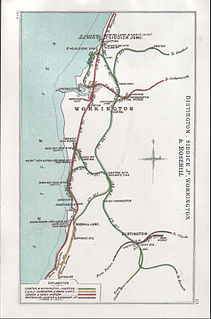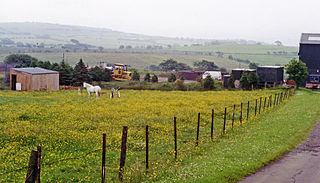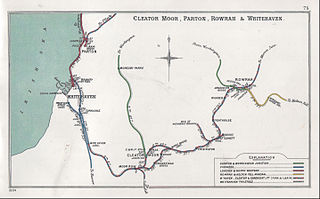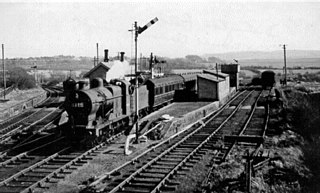
Workington Central railway station was opened by the Cleator and Workington Junction Railway (C&WJR) in 1879 to serve the town of Workington in Cumberland, England. It was situated almost half a mile nearer the town centre than its rival Workington station.

Cleator Moor West railway station was opened as "Cleator Moor" by the Cleator and Workington Junction Railway (C&WJR) in 1879. It served the growing industrial town of Cleator Moor, Cumbria, England.

High Harrington railway station was opened by the Cleator and Workington Junction Railway (C&WJR) in 1879. It was situated half a mile south of Harrington Junction on the company's main line. and served what was then the eastern extremity of Harrington in Cumbria, England. The station is not to be confused with the current Harrington station a kilometre away on the coastal line.

Arlecdon railway station served the village of Arlecdon in the former English county of Cumberland, now part of Cumbria.

Seaton railway station served the village of Seaton, near Workington in Cumberland, England.
Moresby Junction Halt railway station was opened by the Cleator and Workington Junction Railway (C&WJR) in 1910. Very few people lived near the halt, which served nearby Walkmill Colliery and coke ovens in Cumbria, England.
Keekle Colliers' Platform railway station was opened by the Cleator and Workington Junction Railway (C&WJR) in July 1910, closed the following January, reopened in June 1913 then closed for good on 1 October 1923. The halt was provided to enable residents of the isolated Keekle Terrace, less than 100 yds from the track, to get to and from work at the equally isolated Walkmill Colliery and coke ovens in Cumbria, England. The Platform is not shown by Jowett.

Moresby Parks railway station was opened by the Cleator and Workington Junction Railway (C&WJR) in 1879. It was situated just north of the summit of the company's main line and served the scattered community of Moresby Parks in Cumbria, England.
Millgrove railway station was a private station on the Cleator and Workington Junction Railway (C&WJR) main line from Moor Row to Workington Central. It appears to have served the Burnyeat family who lived at a house named Millgrove in Moresby, Cumbria, England, which was near the company's main line. William Burnyeat (1849-1921) was on the company's Board of Directors from 1900 to 1921.

Distington railway station was opened jointly by the Cleator and Workington Junction Railway (C&WJR) and the LNWR and Furness Joint Railway on 1 October 1879. It was situated on the northern edge of the village of Distington, Cumbria, England where the C&WJR's north-south main line crossed the Joint Line's east-west Gilgarran Branch.

Harrington railway station, or Church Road halt, was a railway station in Harrington, Cumbria, England. It was opened by the Cleator and Workington Junction Railway (C&WJR) on the company's Harrington Branch which connected with the Lowca Light Railway at Rosehill to provide a through route from Lowca to Workington Central and beyond.

Rosehill railway station was opened by the Cleator and Workington Junction Railway (C&WJR) on the company's Harrington Branch which connected with the Lowca Light Railway (LLR) at Rosehill to provide a through route from Lowca to Workington Central and beyond.

The Harrington and Lowca Light Railway was a short railway on the coast of Cumberland, which is now part of Cumbria, England.

Siddick Junction railway station was opened by the Cleator and Workington Junction (C&WJR) and London and North Western Railways in 1880 to provide exchange platforms for passengers wishing to change trains from one company's line to the other. A passenger travelling from Maryport to Distington, for example, would change at Siddick Junction. As a purely exchange station - like Dovey Junction and Dukeries Junction elsewhere in the country - the owning companies would not need to provide road or footpath access or ticketing facilities as no passengers were invited to enter or leave the station except by train.

Linefoot railway station, sometimes referred to as Linefoot Junction and sometimes as Linefoot Goods, briefly served the scattered community around the crossroads at Linefoot, near Cockermouth in Cumberland, England.

Oatlands railway station served the village of Pica and Oatlands Colliery in the former English county of Cumberland, now part of Cumbria.

Parton Halt railway station was opened by the LNWR and FR Joint Railway in January 1915 and closed by the LMSR fourteen years later in 1929.

The Gilgarran Branch was a 7-mile-32-chain long (11.9 km) single track railway line connecting four separate railway companies in the former county of Cumberland, now part of Cumbria, England.
Copperas Hill railway station served the small clifftop community of Copperas Hill, south of Harrington in the former county of Cumberland, England, which is now part of Cumbria.

Moss Bay Cart Siding was used for two periods as a temporary northern terminus for workmen's trains to Lowca. It was situated where Moss Bay Road crossed the CWJR's Derwent Branch in southern Workington in the former county of Cumberland, England, which is now part of Cumbria.












